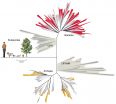Air pollution may contribute to white matter loss in the brain
2015-06-15
(Press-News.org) In a new study, older women who lived in places with higher air pollution had significantly reduced white matter in the brain. For the study, a research team took brain MRIs of 1403 women who were 71 to 89 years old and used residential histories and air monitoring data to estimate their exposure to air pollution in the previous 6 to 7 years.
The findings suggest that ambient particulate air pollutants may have a deleterious effect on brain aging.
"Investigating the impact of air pollution on the human brain is a new area of environmental neurosciences. Our study provides the convincing evidence that several parts of the aging brain, especially the white matter, are an important target of neurotoxic effects induced by long-term exposure to fine particles in the ambient air," said Dr. Jiu-Chiuan Chen, lead author of the Annals of Neurology study.
INFORMATION:
ELSE PRESS RELEASES FROM THIS DATE:
2015-06-15
The prevalence of smoking among undergraduate nursing and physiotherapy students in Spain decreased from 29.3% in 2003 to 18.2% in 2013. Many of the students remained unaware of the link between smoking and diseases such as bladder cancer or the negative health effects of second-hand smoke, which points to a significant deficiency in undergraduate training.
The majority of nursing and physiotherapy students recognized that healthcare professionals were role models in society, noted Dr. Beatriz Ordás, lead author of the Journal of Advanced Nursing study.
INFORMATION: ...
2015-06-15
Following a decade of steady growth, use of bisphosphonates--medications that are effective for treating osteoporosis--declined in the United States by more than 50% from 2008 to 2012.
The sudden drop seemed to occur after media reports highlighted safety concerns, such as the development of certain fractures that occurred rarely in long-term users, despite the fact that the US Food and Drug Administration and the American Society of Bone and Mineral Research did not recommend any specific safety restrictions on bisphosphonates. The findings are published in the Journal ...
2015-06-15
A new study shows that shorter telomeres--which are the protective caps at the end of a cell's chromosomes--are linked with worse survival in a progressive respiratory disease called idiopathic pulmonary fibrosis (IPF). In patients with IPF, excessive scar tissue forms in the lungs.
The average telomere length of IPF patients was significantly shorter than that of healthy individuals. Also, the telomere length of patients with IPF who died from their disease during the study was shorter than that of patients who survived.
The Respirology results support the theory that ...
2015-06-15
A new global review reveals that elder abuse--which includes psychological, physical, and sexual abuse; neglect; and financial exploitation--is common among community-dwelling older adults and is especially prevalent among minority older adults. Older adults with cognitive and physical impairments or psychosocial distress are also at increased risk of elder abuse.
In North and South American epidemiological studies, the prevalence of elder abuse ranged from about 10% among cognitively intact older adults to 47% in older adults with dementia. In Europe, the prevalence ...
2015-06-15
One of the body's own tools for preventing wound infections may actually interfere with wound healing, according to new research from Boston Children's Hospital. In a study published online in Nature Medicine, scientists from the hospital's Program in Cellular and Molecular Medicine (PCMM) found they could speed up wound healing in diabetic mice by keeping immune cells called neutrophils from producing bacteria-trapping neutrophil extracellular traps (NETs).
The study, led by PCMM senior investigator Denisa Wagner, Ph.D., and postdoctoral fellow Siu Ling Wong, Ph.D., ...
2015-06-15
University of California, Berkeley, scientists have identified more than 35 new groups of bacteria, clarifying a mysterious branch of the tree of life that has been hazy because these microbes can't be reared and studied in the lab.
The new groups make up more than 15 percent of all known groups or phyla of bacteria, the scientists say, and include the smallest life forms on Earth, microbes a mere 400 nanometers across. The number of new bacterial phyla is equal to all the known animal phyla on Earth.
The scientists, who recently also identified nine new groups of microbes ...
2015-06-15
Researchers estimate that 48.5 percent of the nearly 346,000 deaths from 12 cancers among adults 35 and older in 2011 were attributable to cigarette smoking, according to an article published online by JAMA Internal Medicine.
Researcher Rebecca L. Siegel, M.P.H., of the American Cancer Society, Atlanta, and coauthors provide an updated estimate because they note smoking patterns and the magnitude of the association between smoking and cancer death have changed in the past decade. While smoking prevalence decreased from 23.2 percent in 2000 to 18.1 percent in 2012, some ...
2015-06-15
New York, June 15 -- Led by Young Duck Kim, a postdoctoral research scientist in James Hone's group at Columbia Engineering, a team of scientists from Columbia, Seoul National University (SNU), and Korea Research Institute of Standards and Science (KRISS) reported today that they have demonstrated -- for the first time -- an on-chip visible light source using graphene, an atomically thin and perfectly crystalline form of carbon, as a filament. They attached small strips of graphene to metal electrodes, suspended the strips above the substrate, and passed a current through ...
2015-06-15
Diatoms in the world's oceans exhale more oxygen than all the world's rainforests. These tiny drifting algae generate about 20 percent of the oxygen produced on Earth each year and invisibly recycle gases enveloping our planet.
How diatoms will respond to the rising carbon dioxide levels is still unknown. A new study by the University of Washington and Seattle's Institute for Systems Biology, published June 15 in Nature Climate Change, finds the genetic ways that a common species of diatom adjusts to sudden and long-term increases in carbon dioxide.
'There are certain ...
2015-06-15
Does participation in the annual lung cancer screening currently recommended for people with high-risk smoking histories encourage those who are still smoking to quit? A new study from a Massachusetts General Hospital research team (MGH) finds that the answer may depend on the level of support given by patients' primary care providers. In the report receiving online publication in JAMA Internal Medicine, the team finds that, while providers' asking such patients about smoking did not increase their likelihood of quitting, providing more direct assistance - such as talking ...
LAST 30 PRESS RELEASES:
[Press-News.org] Air pollution may contribute to white matter loss in the brain

